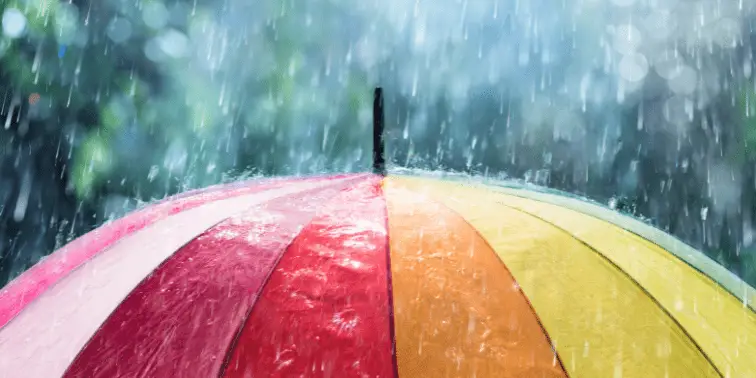New homes are new beginnings; it’s turning over a new leaf somewhere else—hopefully an upgrade!
Thing is, moving can be stressful if you’re not prepared enough. Even with minor setbacks, people can often take any trouble as a sign of bad luck.
What about moving on a rainy day? Is it challenging? What if you need to move while it’s pouring outside? Let’s see what we can do to help make your moving day a breeze!
Table of Contents
How to Load a Moving Truck in Rainy Weather
Your main goal in this stage is to make the most out of your truck space. You’ll also want to make sure your layout order makes sense when you’re unloading later on.
Line Up
Once you’re done packing, get everything in the same place. This will help you avoid dragging mud and water around the old house trying to find the next box. It’ll also reduce the odds of leaving something behind.
To make things easier, stack things in reverse order to how you want to load them in your truck.
If you want the heaviest stuff to go in the truck first, pack them last. Just keep in mind that they’ll get unloaded last, too.
Try to stack the biggest boxes down, then layer above them smaller objects. This way, you’ll be balancing the weight evenly across the truck. This is a good approach if you have a particularly large truck.
Remember that you should never stack boxes on top of fragile materials. Line them separately and load them last.
Dress for the Occasion

It isn’t enough to just seal up your furniture covers and boxes. You’ll need to protect yourself from getting soaked. Some apparel options to consider include:
- Umbrellas
- Rain boots
- Overshoes
- Waterproof coats
- Coats
Lift from the Bottom
Even if you choose really sturdy cardboard boxes, you should support the corners. Water eats away at the corners particularly quickly, and before you know it, the box breaks open.
Lift all the boxes (cardboard or plastic) with care, but pay particular attention to boxes that contain fragile items. One slip on wet floors, and you’ll break valuable items!
Mats Are Your New Best Friends
Lay down non-slip mats all the way from the line-up room to your front door. Not only will it save you some accidental falls, but it’ll also protect the bottom of your boxes from getting soaked.
Yes, they can be a little bit expensive, but they’re still way cheaper than buying a new TV or, even worse, a trip to the Emergency Room because of a slip and fall!
How to Drive a Moving Truck in Rainy Weather
Driving trucks is a tad bit trickier than driving smaller cars. Add some wet streets and a foggy view to the mix, and you’ll be in for a challenge.
Know that your number one priority is to arrive safely. Next, you want to make sure that your stuff arrives intact and dry. Here are some tips to help:
Know Your Route
A day or two ahead of time, take a drive out to the new location. Check out all the possible routes and pick the most suitable one. There are a lot of factors that could affect your choices, like traffic or distance.
However, we recommend going with safety over distance. Shortcuts might seem enticing, but you shouldn’t risk it in bad weather with a loaded truck.
Prepare everything you’ll need beforehand; your driver’s license and any passes or parking IDs you might need. Don’t forget to fill the gas tank earlier that day.
Drive Safe

Rain isn’t just a minor inconvenience; driving in strong showers can be dangerous. Here are a few tips to help you drive a moving truck safely:
- Don’t rush. Drive slowly and carefully, especially if you aren’t used to driving trucks.
- Take it easy on the breaks.
- Leave a decent amount of space between the truck and other vehicles.
- Clean your lights and check your wipers before driving.
- Always remember to wear your seatbelt.
Of course, getting a professional to drive your moving truck is always an option. Hydroplaning in rainy weather is very serious!
Pick a Drive Partner
Having someone along the road with you is a huge plus. You’ll keep each other company. This way you can navigate the way and keep an eye out on the road too.
A suitable drive partner is crucial if your trip is long. It’ll be easier (and safer!) to take turns driving.
However, we really wouldn’t recommend having a bunch of people and kids with you in a moving truck. One friend is plenty for the road.
Get any excess passengers to drive ahead of you in a different vehicle. This is a win-win because they’ll get the new home ready before the truck arrives.
How to Unload a Moving Truck in Rainy Weather
Finally, you can start unloading the truck. By now, you’ll probably be tired and worn out. Just try power through it; you don’t want to waste all that hard work.
Don’t Walk a Block
The last thing you want when you arrive is to have to walk in the rain with your stuff. Try to park as close as possible to the new location. Book a space in advance, if you have to.
This is important since finding parking spaces for moving trucks is harder than regular cars. You can even talk to your landlord about accommodating a parking space for you that day.
Pro Tip: In some cities you can call the city to have a space on the street reserved for you. We were able to do this in Philly and it was total gamechanger!
Unpack Quickly
If you took our advice and sent some family members ahead of you, the house should be ready to unload the stuff into. If not, you might want to take 30 mins or so to clear out the way for the packages. Make sure that your unloading space is empty, dry, and well lit.
Get someone to unpack as soon as the boxes start arriving. This will help you re-use the boxes again. The unpacked boxes can be used to reinforce other vulnerable packages.
You could also carpet the floor with a few dry cardboard boxes to protect the floor from water and scratches.
Wait for Grace Periods

You can probably handle moving lightboxes from the truck and into the house quickly. When it comes to heavier items, you’ll need a bit of cunning.
In most cases, the rain will calm down for a while. Try to use this grace period in your favor and move the heaviest, most valuable stuff. Leave the lighter stuff for later; they won’t require much effort from you anyway, and you’ll be able to get them inside quickly.
Once you’re done moving the electronics, unpack them and keep them aside. We recommend that you always keep electric devices in waterproof boxes or sealed bags. It’s also a good idea to wait till your electronics are fully dried out before plugging them in.
Items You’ll Need for Moving on a Rainy Day
Being prepared is the key to a smooth moving day. Besides the boxes, labels, and tape, you’ll need the following items:
Mats
We’ve mentioned mats already, but we can’t stress this enough, but waterproof mats will save you a ton of effort. Throughout the day, you’ll be moving around quickly, and you don’t want to slip on a wet floor and fall.
Towels
Gather all your worn-out towels; you’ll finally put them to use! You can also get a bunch of cheap towels in different sizes.
Put aside a stack for the driving truck, just in case the truck’s roof leaks down on the boxes. Consider putting aside another stack for drying the boxes as soon as they arrive. Keep some towels to dry yourself, too.
When you’re done moving, you can either keep the towels around for cleaning or donate them to thrift stores and shelters.
Sturdy Moving Boxes
Regular moving boxes will handle slight drizzles, but heavy rain will wear the cardboard out very quickly. There are a few ways you can get the most out of cardboard boxes, though:
- Line the box with waterproof liners. If you’d rather DIY it, try lining the box with plastic bags instead.
- Seal the box from the outside. You can wrap it with plastic bags, or just tape it around the corners and the seams.
Plastic boxes are more convenient, but they can be relatively expensive. Save the plastics for the most valuable items, like electronics. The rest can go in sealed cardboard boxes.
Helping Hand
Moving is already a daunting task; imagine doing it in bad weather! You don’t want to do it alone. Having a friend or two will make your day that much easier.
If you can’t get anyone to move with you, look into moving services that offer helpers and drivers.
Final Thoughts
Moving in rainy weather can be challenging, but it’s definitely doable. As long as you take a few days to prepare, you’ll manage to keep your furniture dry and your valuables intact.
Large towels, plastic bags, furniture covers, and cardboard box liners are all must-haves when you’re moving on a rainy day.
In the end, try to stay safe, and remember, every cloud has a silver lining!


